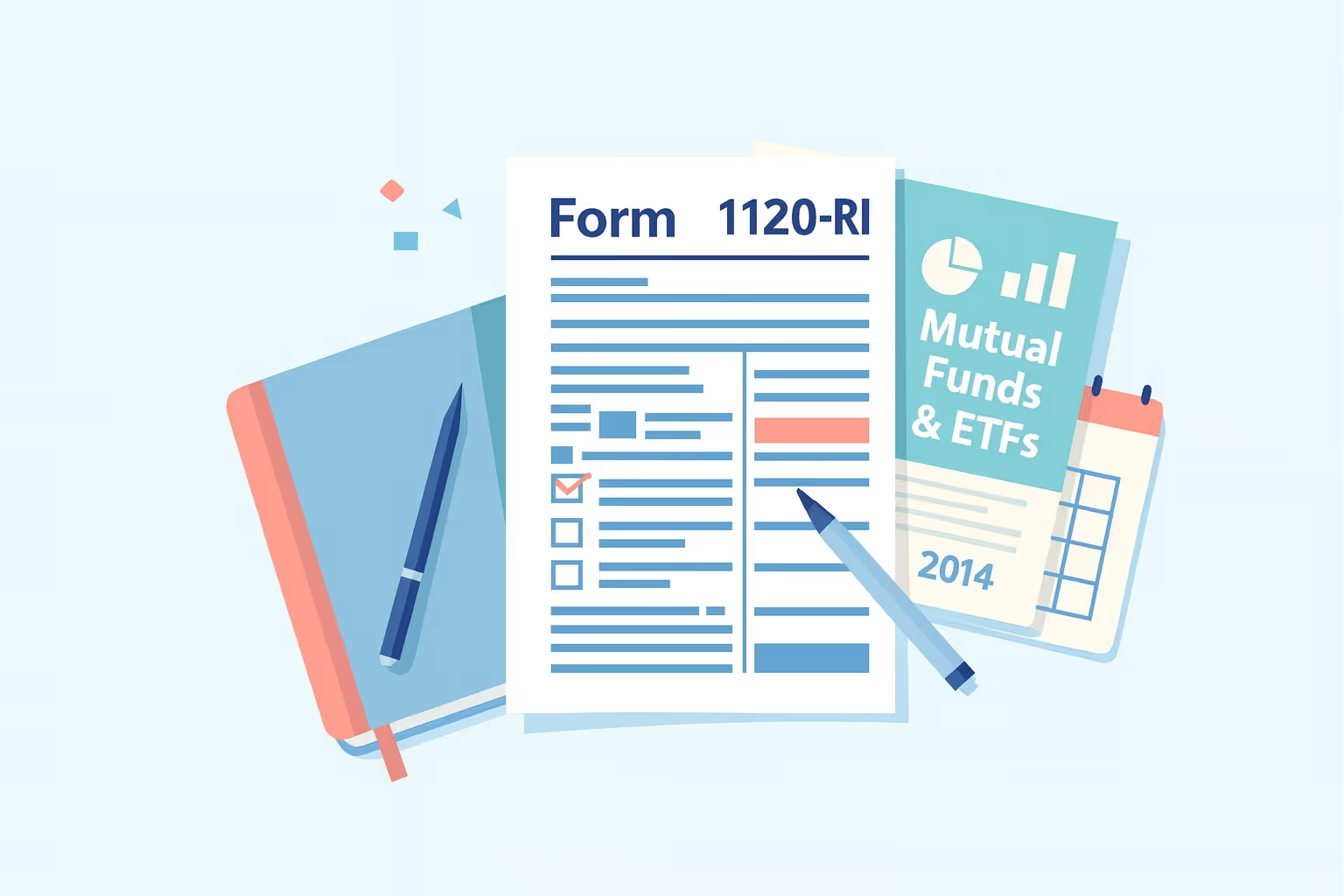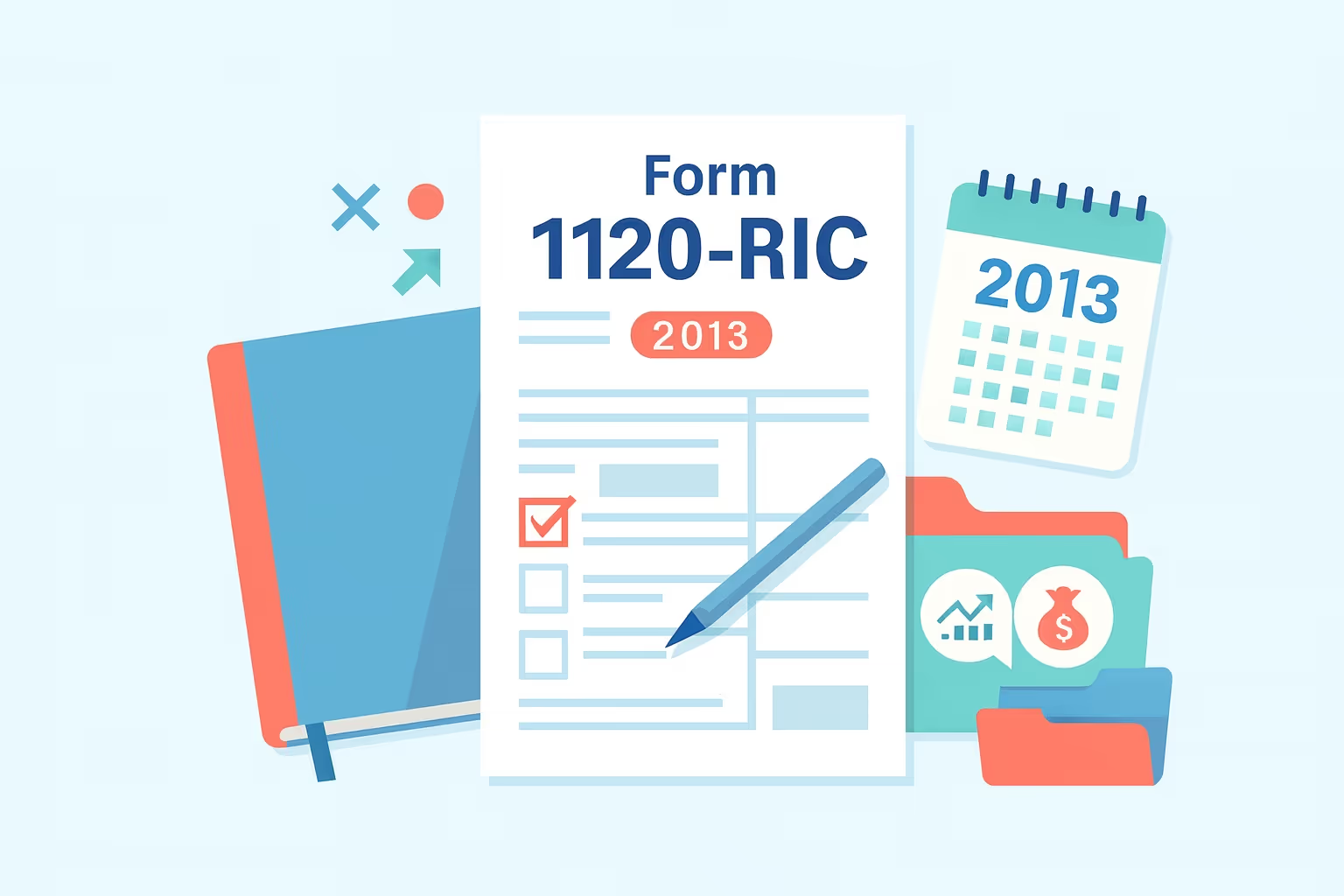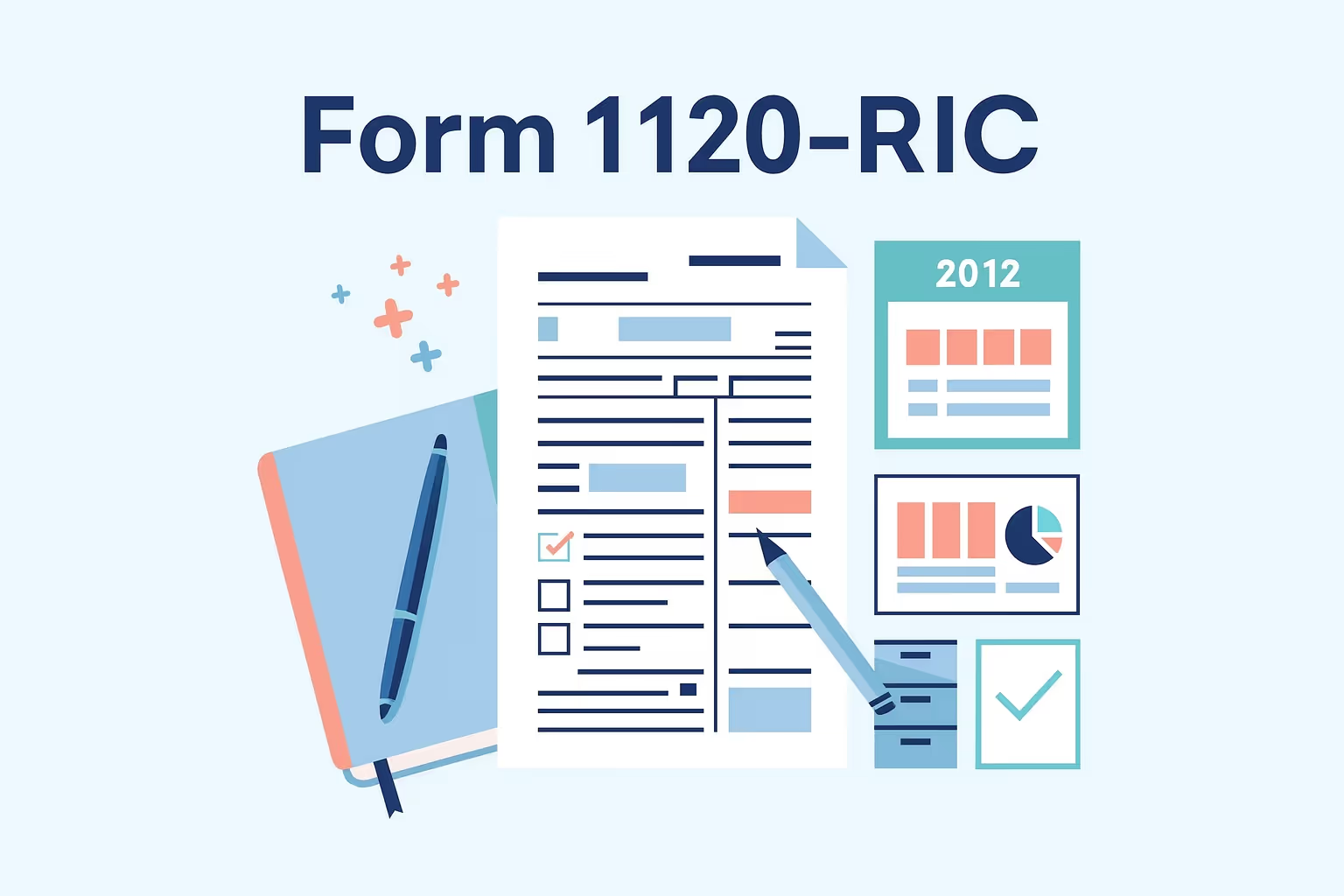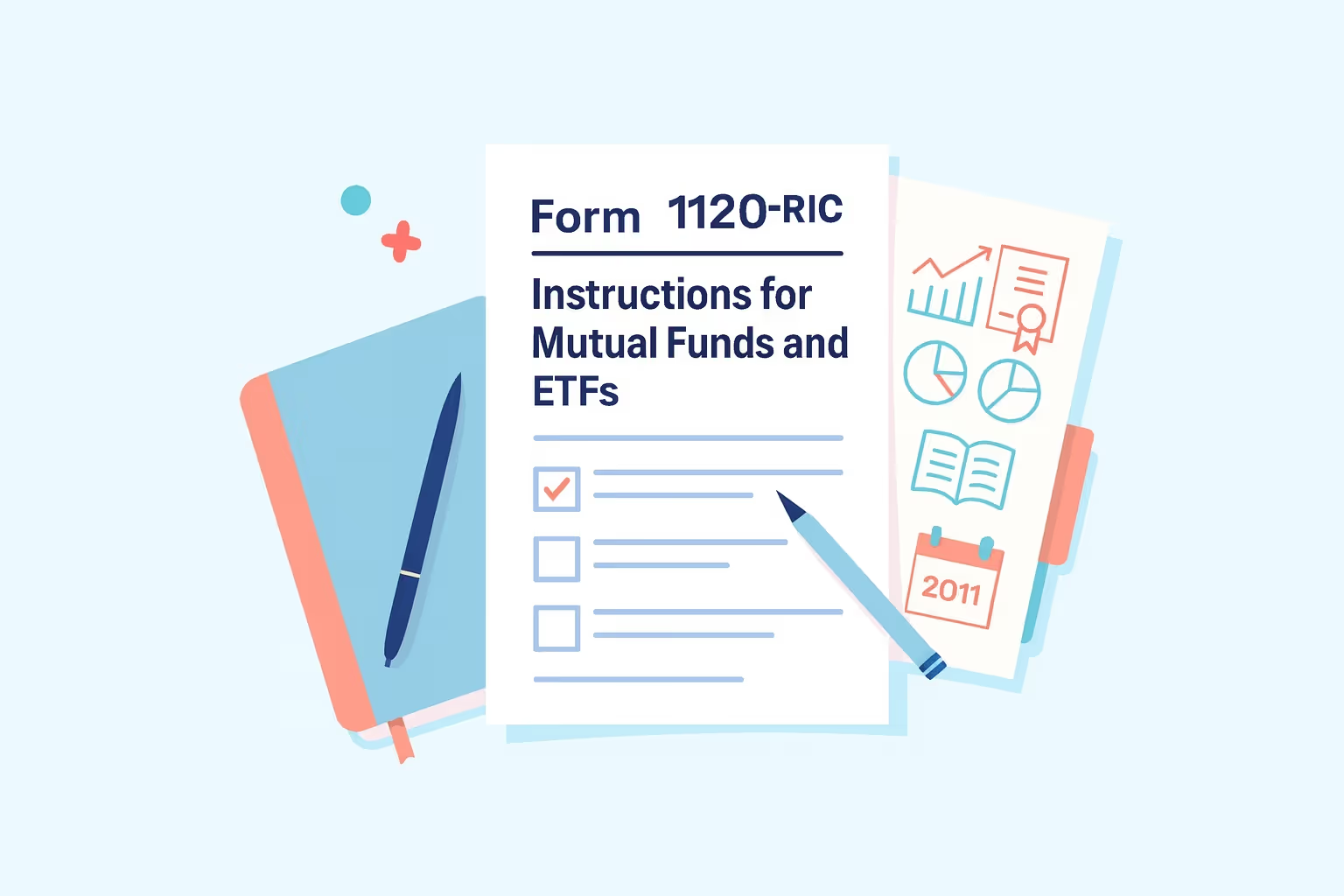Form 1120-RIC 2016 Instructions: Step-by-Step Filing Guide
Form 1120-RIC is the federal income tax return used by regulated investment companies, including mutual funds, exchange-traded funds, and certain unit investment trusts. This form enables qualifying investment companies to report their investment company taxable income, deductions, and dividends distributed to shareholders, thereby avoiding double taxation at the corporate level. By passing through income and capital gains, these companies ensure investors are taxed only once on distributed earnings.
For the 2017 tax year, the Internal Revenue Service provided separate instructions for completing Form 1120-RIC. These instructions guide domestic corporations that have elected RIC status under the Investment Company Act and the Securities and Exchange Commission registration requirements. They explain how to compute taxable income, account for dividends paid, and apply deductions for accounting and legal services, custodian fees, and other expenses related to managing investment opportunities.
Accurate completion of this income tax return helps maintain compliance with RIC qualification tests and supports consistent reporting of net investment income, capital gain dividends, and other income categories. The following sections outline a straightforward, step-by-step process for preparing and filing Form 1120-RIC for the 2017 tax year, helping investment companies meet their filing obligations efficiently and in accordance with IRS requirements.
What Is Form 1120-RIC and Who Must File It?
Form 1120-RIC is the U.S. income tax return used by regulated investment companies to report taxable income, deductions, and distributions to shareholders. It applies to investment entities such as mutual funds, exchange-traded funds, and specific unit investment trusts that qualify for special tax treatment under the Internal Revenue Code. This form ensures that these entities can pass through income, capital gains, and other earnings to shareholders, preventing double taxation at the corporate level.
Key Features of Form 1120-RIC
- It serves as the annual income tax return for corporations that elect to be treated as regulated investment companies under Section 851 of the Internal Revenue Code.
- It reports total income, total deductions, and taxable income before deducting the dividend payment.
- It calculates the company’s total tax after accounting for employment credits, foreign tax credits, and other applicable deductions.
- It requires accompanying schedules, such as Schedule D for capital gains and losses, as well as other IRS forms that detail investments, dividends, and credits.
Who Must File Form 1120-RIC?
A domestic corporation must file Form 1120-RIC if it:
- Elects RIC status or has an existing RIC election that has not been revoked.
- It is registered under the Investment Company Act and regulated by the Securities and Exchange Commission.
- Meets specific qualification tests related to income, asset composition, and distribution of taxable income to shareholders.
- Maintains investments in securities, government securities, or other qualifying assets that produce gross income subject to RIC rules.
Benefits of RIC Status
- The company avoids corporate-level income taxes on distributed income.
- It can deduct dividends paid to shareholders, including exempt interest dividends and capital gain dividends.
- It maintains favorable tax treatment for net investment income and net capital gain distributions.
- It preserves eligibility for certain credits, such as those related to tax credit bonds.
Form 1120-RIC helps regulated investment companies comply with federal tax laws while maintaining their election status. Understanding its filing requirements ensures proper reporting of investment company taxable income and accurate calculation of taxes imposed by the Internal Revenue Service.
What’s New for the 2017 Tax Year?
The 2017 tax year introduced several updates to the filing process for regulated investment companies. These changes impact filing deadlines, penalties, and methods for computing taxable income. Understanding the updates helps companies prepare accurate tax returns and avoid compliance issues.
Key Updates for 2017
- The due date for filing Form 1120-RIC changed to the 15th day of the fourth month after the end of the tax year for most filers. Calendar-year RICs were required to file by April 17, 2018.
- RICs with fiscal years ending June 30 must file by the 15th day of the third month after year-end.
- Penalties for late filing increased. For returns filed more than 60 days late, the minimum penalty is the smaller of the tax due or $205.
- Companies with qualified timber gains must apply an alternative tax calculation under Section 1201(b)(2).
- Specific filing procedures were adjusted under the Paperwork Reduction Act Notice, including revised IRS forms and e-filing standards.
These revisions emphasize the importance of timely filing, accurate reporting of income, and compliance with the updated tax computation rules for investment companies.
Step-by-Step Guide to Completing Form 1120-RIC
Filing Form 1120-RIC requires precise documentation and accurate reporting of investment company taxable income, deductions, and distributions. The steps below outline the correct process for completing the form.
Step 1 – Gather Required Documents.
Before starting, companies should collect all financial and regulatory documentation.
- Prior-year tax returns, financial statements, and trial balances should be reviewed for reference.
- Dividend, interest, and capital gain records must be compiled to determine taxable income.
- Forms for foreign tax credits, capital gain distributions, and other income should be prepared.
- Documentation for custodian fees, legal services, and accounting expenses should be included.
- Shareholder distribution records, investment portfolio details, and registration information under the Investment Company Act must be verified.
Step 2 – Fill Out Company Information.
- Enter the company’s legal name, address, and employer identification number.
- Indicate the date of incorporation and total assets at the end of the tax year.
- Check applicable boxes for amended, final, or name-change returns.
- Ensure that the calendar year or fiscal year selection matches the company's records.
Step 3 – Complete Part I: Investment Company Taxable Income.
- Report gross income, including dividends, interest, and net foreign currency gain.
- Deduct allowable expenses such as investment advisory fees, accounting, and legal services.
- Include custodian fees, registration fees, and other deductions related to managing the company’s assets.
- Compute taxable income before applying the dividends paid deduction.
Step 4 – Calculate the Dividends Paid Deduction (Schedule A).
- Report all dividends paid to shareholders during the tax year.
- Include consent and deficiency dividends with the required forms.
- Account for capital gain dividends and exempt interest dividends distributed to shareholders.
- Ensure totals align with other schedules and statements attached to the return.
Step 5 – Compute Tax Liability (Schedule J).
- Determine the total tax after applying employment credits, foreign tax credits, and subtracting employment credits.
- Include estimated tax payments and adjustments for overpayments or balances due.
- Calculate total income and total deductions accurately to determine the tax imposed.
- Review the preparer shown and verify that all accompanying schedules are complete.
Completing these steps ensures accurate computation of taxable income and compliance with IRS filing requirements for investment companies.
Filing and Payment Methods
Proper filing and payment methods are essential for the timely submission and error-free processing of Form 1120-RIC. Regulated investment companies may choose between electronic and paper filing options, depending on their preference and the status of their filings.
Electronic Filing (E-File)
- Electronic filing provides faster processing, immediate acknowledgment, and reduced calculation errors.
- It enables the secure transmission of sensitive financial data and performs automatic checks for inconsistencies.
- Companies can retain electronic copies for record-keeping and future reference.
Paper Filing
- Paper filing is still accepted for RICs that do not use electronic filing systems.
- Returns must be completed in black ink and signed by authorized officers.
- All required schedules, statements, and attachments must be included with the return.
- The mailing address depends on the company’s principal place of business, as specified in IRS instructions.
Making Payments via EFTPS
- All federal tax deposits must be made electronically using the Electronic Federal Tax Payment System.
- Payments for corporate income taxes, employment credits, and estimated taxes should be scheduled in advance.
- Companies can also use same-day wire or card payments, depending on processing times.
- For calendar-year RICs, payment is due by the return’s filing date to avoid penalties and interest.
Timely filing and accurate payment submission are essential for compliance. Using EFTPS ensures reliability and reduces administrative delays for both the filer and the IRS.
Required Schedules, Attachments, and Elections
Form 1120-RIC requires several schedules and supporting documents depending on the company’s operations, income sources, and deductions. These attachments help ensure transparency and compliance with IRS reporting requirements.
Core Schedules
- Schedule A details the deduction for dividends paid, including consent and deficiency dividends.
- Schedule B provides information on tax-exempt obligations and exempt interest and dividend income.
- Schedule J is used to calculate total tax, applying credits and adjustments.
- Schedule K collects general company information, including accounting methods and shareholder data.
- Schedules L, M-1, and M-2 reconcile book and tax income and analyze retained earnings.
Common Additional Forms
- Schedule D reports capital gains and losses from sales of securities or other investments.
- Form 4797 documents the sale of business property.
- Form 1125-E reports compensation of officers and executive staff.
- Form 1118 claims foreign tax credits for taxes paid to other countries.
- Form 8613 applies to the excise tax on undistributed income.
Elections and Statements
- Section 852 elections allow the company to pass through dividends and interest income.
- Section 853 elections permit shareholders to claim foreign tax credits.
- Section 853A covers credits from tax credit bonds.
- Section 852(b)(8) governs spillover dividends distributed after the tax year end.
Including all required schedules and elections ensures that the income tax return accurately represents the company’s activities and maintains RIC compliance.
Key Qualification Tests for Maintaining RIC Status
A corporation must meet specific qualification tests each tax year to maintain its status as a regulated investment company. These tests verify income sources, asset composition, and required distributions to shareholders.
Income Test (90%)
- At least 90% of the company’s gross income must come from dividends, interest, payments on securities loans, and capital gains from securities or foreign currencies.
- Income from qualified publicly traded partnerships may also count toward this threshold.
- Companies should monitor monthly income reports to confirm compliance.
Asset Test (50% and 25%)
- At the end of each quarter, at least 50% of the company’s assets must consist of government securities, securities of other RICs, or other investments with limits on single issuers.
- No more than 25% of the company’s total value may be invested in the securities of one issuer or two or more related issuers engaged in the same trade or business.
- Companies should document asset valuations every quarter to ensure compliance with relevant regulations.
Distribution Requirement (90%)
- At least 90% of the investment company's taxable income and related tax-exempt interest must be distributed as dividends to shareholders each year.
- Distributions may include ordinary dividends, capital gain dividends, and exempt interest dividends.
- The timing of distributions should align with the company’s declared policy to maintain its RIC election.
Meeting these qualification tests helps a regulated investment company retain its pass-through status and avoid taxation as a regular corporation.
Avoiding Common Filing Errors
Accurate reporting on Form 1120-RIC prevents penalties, delays, and the risk of losing RIC status. The following are common errors companies should avoid when preparing their returns.
Filing and Calculation Errors
- Late filing can lead to penalties of 5% per month on unpaid taxes. Filing extensions through Form 7004 should be requested when needed.
- Incorrect calculation of total income or total deductions can affect taxable income and total tax due. Companies should double-check all figures and attached schedules.
- Omission of schedules, such as Schedule D or Form 8613, may result in incomplete filings.
Information and Documentation Mistakes
- Missing employer identification numbers, incorrect tax year entries, or unchecked applicable boxes cause processing delays.
- Inconsistent information between financial statements and accompanying schedules may trigger an IRS review.
- Omitting details for legal services, accounting fees, or custodian charges may result in underestimating total deductions.
Record-Keeping Issues
- Records supporting income, asset composition, and dividends paid should be retained for at least three years from the filing date.
- Documentation should include investment portfolios, distribution authorizations, and supporting statements for foreign tax credits, as applicable.
By avoiding these common mistakes, investment companies can maintain compliance and ensure accurate reporting of taxable income in accordance with the Internal Revenue Service's guidelines, as outlined by the Treasury.
Zero-Activity and Dormant RIC Returns
Even when a regulated investment company has no income or activity for the tax year, filing Form 1120-RIC may still be required. Maintaining compliance ensures the company’s RIC election remains valid and avoids penalties for non-filing.
When a Zero-Activity Return Is Required?
- The company retains its RIC election under Section 851, even if it has no income or operations.
- The company remains registered with the Securities and Exchange Commission.
- There are undistributed earnings or profits from prior years that must still be reported.
- The company holds minimal investments or assets that generate incidental income, such as interest.
Completing a Zero-Activity Return
- Enter the company’s identifying information, tax year, and employer identification number.
- Input “0” for all income and deduction lines.
- Complete Schedule K and other required statements to maintain consistency with previous filings.
- Attach any necessary balance sheets or supporting documents if the company’s total assets exceed $25,000.
- Sign and date the return before the filing deadline.
Considerations for Dormant Companies
- Corporations expecting long-term inactivity may choose to revoke their RIC election.
- If the company is no longer operating, it may deregister under the Investment Company Act or formally dissolve.
- These actions should be discussed with tax and legal advisors due to potential implications for corporate income taxes and future reinstatement.
Filing even a zero-activity return helps companies maintain good standing and avoid potential compliance risks with the IRS.
Tips for First-Time Filers
Preparing Form 1120-RIC for the first time requires understanding qualification requirements, filing procedures, and the documentation needed to support the company’s RIC status.
Making the RIC Election
- A corporation elects RIC status by computing taxable income as a regulated investment company on Form 1120-RIC.
- The election must meet all qualification tests under Section 851 of the Internal Revenue Code.
- Once the election is made, it remains effective unless revoked or terminated.
Pre-Filing Preparation Checklist
- Obtain an Employer Identification Number (EIN) if one has not already been assigned.
- Register with the Securities and Exchange Commission if required under the Investment Company Act.
- Set up an accounting system to track gross income, deductions, and asset diversification.
- Enroll in the Electronic Federal Tax Payment System for tax deposits and estimated payments.
- Review qualification requirements and schedule regular compliance reviews to ensure ongoing adherence to these requirements.
- Prepare the necessary forms, such as Form 4797, Schedule D, and Form 1118, in advance.
Common First-Year Mistakes
- Some filers skip quarterly asset tests and fail to maintain diversification.
- Many do not meet the 90% income and distribution tests required for RIC status.
- Filing late or missing required schedules often leads to penalties.
- Poor record-keeping can lead to errors in calculating taxable income.
- Filers forget to deduct accounting, legal, or custodian fees.
- Errors occur when reporting net investment income or capital gain dividends.
- Some returns have incorrect employer identification numbers or unchecked boxes.
Following these preparation steps helps first-time filers establish strong compliance practices and maintain RIC election status without interruption.
Frequently Asked Questions
What is Form 1120-RIC, and who must file it?
Form 1120-RIC is the income tax return used by regulated investment companies such as mutual funds, exchange-traded funds, and unit investment trusts. A domestic corporation that has made a RIC status election under the Investment Company Act must file this form. It reports investment company taxable income, dividends paid, capital gains, and total deductions for each tax year to the Internal Revenue Service.
How is an investment company's taxable income computed?
Investment company taxable income is determined by computing taxable income before the dividends paid deduction. It includes gross income from dividends, interest, and net foreign currency gain, less employment credits and other deductions. Companies should also report capital gain dividends, tax-exempt interest, and other income sources on accompanying schedules to ensure accurate total tax calculation and compliance with the Paperwork Reduction Act Notice.
What are the qualification requirements for regulated investment companies?
To qualify as regulated investment companies, corporations must meet three main tests under the Investment Company Act. They must derive at least 90% of gross income from qualifying investments such as government securities, dividends, and interest. They must also meet quarterly asset diversification tests and distribute at least 90% of taxable income and tax-exempt interest to individual shareholders each calendar year.
How do dividends paid affect taxable income on Form 1120-RIC?
Dividends paid reduce the investment company’s taxable income by allowing a deduction for amounts distributed to shareholders. These may include ordinary dividends, capital gain dividends, and exempt interest dividends. By distributing income and gains, a company avoids double taxation at both the corporate and shareholder levels. All amounts must be accurately reported in Schedule A and supporting IRS forms to confirm compliance with the income test.
What expenses can be deducted by regulated investment companies?
Regulated investment companies may deduct ordinary and necessary business expenses, including accounting and legal services, investment advisory fees, custodian fees, and registration fees paid to the Securities and Exchange Commission. Additional deductions may include interest, registration under the Securities and Exchange Commission, and other operating costs related to managing the company’s assets and direct investments. Each deduction for regulated investment companies should be listed on the return, accompanied by proper documentation.
How should an investment company report capital gains and other income?
An investment company must use Schedule D to report capital gains, net capital gain, and other income from securities loans or direct investments. Gains should be categorized by short-term and long-term holding periods. Total income, total deductions, and total tax must accurately reflect the computation of taxable income across all applicable boxes and accompanying schedules. The preparer shown should confirm all figures before submission.
What are the payment and filing requirements for Form 1120-RIC?
The tax imposed on regulated investment companies is due by the date the return is filed. Payments must be made through the Electronic Federal Tax Payment System, following the separate instructions in IRS forms. Companies must check applicable boxes for calendar year or fiscal year filings, include all accompanying schedules, and sign the final return. Accurate completion helps ensure the Treasury Internal Revenue Service processes the form without delay.


























